For me, stone carving was always a secret dream — a mysterious craft, something only true artists could achieve: liberated, initiated people who had chosen their vocation courageously, rising above the petty fears of average people like me, who preferred to be on the safe side of life with a regular income and insurances for all sorts of mishaps in life. So I thought.
Then my holidays came into sight. This time I was determined to do something special, more experimental, possibly abroad. The things I would have done 20 years ago, before work routine had got the grip of me. At first I had searched the internet for opportunities for sculpturing in clay (which I had done before). But then I saw the stone carving course in Scotland. Why not give it a go? One doesn’t have to be a Rodin, anyway. And even if I would turn out to be an abject failure, I could still enjoy the beautiful countryside, that’s for sure. Moreover, it would be a great opportunity to see old friends again.
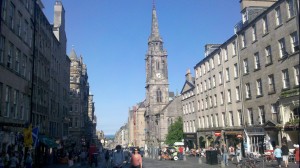
My increasing anticipation was such that it was only at the hotel in Edinburgh that I realized I had arrived one day early! No matter. It had been nearly 15 years since I had been here and just being back was great. With the city buzzing around me, the day went past in no time at all.
And so, finally, I was walking down the stairs to meet everybody else for the welcome drink in the beautifully lit wine bar: Ellen, Ute, Julia and Jeanette. After 10 minutes, Ute and myself had found out that she had been to my firm in Germany only a week before and that we had probably passed each other in the canteen without knowing each other, and after three hours over a wonderful welcome dinner we knew what everybody was doing and what brought us to the course – the first of its kind with Wild at Art Scotland, Ellen told us. She and Ute are the Directors of Wild at Art. So we would be all part of a premiere!
Cambo Estate
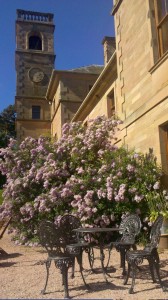
Next day we headed off for Cambo Estate at the coast of Five – having tucked away our professional sketch books after our inspirational visit to the National Museum of Scotland. Susheila, our instructor, who had joined us by breakfast explained the Pictish carvings to us, which were clearly the focus of our visit. She is a sculptor herself and an award-winning one, too. To me, her most striking feature is her ability to welcome people in and encourage them to discover things for themselves without putting on any pressure. She makes one feel that art is for everybody and that working on different levels is no problem at all. Therefore, I was not surprised when a few days later she would have to take time off to collect an award for her educational work! Being an excellent sculptor is one thing, being an excellent tutor is another. Susheila is both.
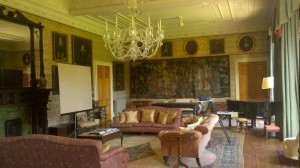
Yes, the drawing room really does look like the picture on the website. And there is much more! One feels like entering history itself. With most of the house remaining in original 19th century style we found ourselves walking around absolutely bedazzled by the place. At first, I had difficulties remembering the exact whereabouts of my room. Sir Peter Erskine, who owns Cambo together with his wife Lady Catherine, gave us a tour through the house, parts of which they have opened to the public. Sir Peter is a descendent of the 1st Earl of Kellie, an aristocrat, who was Captain of the Guard and Groom of the Stool for James VI (1566 – 1625), the son of Mary Stuart. That basically means he (the Earl) oversaw the future king‘s education after Mary was executed. The estate burnt down in the late 19th century and was rebuilt in the style of that time in which it has been kept until now.
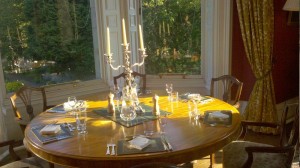
Adjustments have been sensitively made to suit the demands of today. While Ellen, Ute and Susheila were accommodated in the romantic cosy attic apartment whereas Julia, Jeanette and myself shared the beautiful and spacious flat which used to be the former Lower Servants Wing. Our breakfasts were served at the round table in the big dining room with a great view on parts of the gardens. In fact, most visitors come to take a walk through the artistic gardens, to buy plants or take part in gardening workshops, to have a cup of coffee and a piece of home made cake or buy a souvenir in the little Cambo shop. The head gardener, Elliot Forsyth, was recently awarded an Award of Merit for Services to Horticulture by the Royal Caledonian Horticultural Society, so I read in the Cambo Courier. That‘s all one needs to know about the Cambo garden. Everything else has to be seen for real!
Getting to „work“
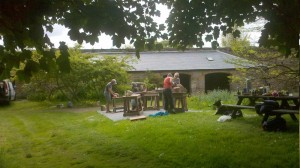
It is along bamboo shrubs, wild garlic, over a lovely wooden bridge and along a semi-wild river we make our way to the former stables of the estate. There, our stones are waiting for us! Susheila has set out a whole gallery of stones for us to choose from — slender as she is, she seems made of solid steel. Most of the stones are sandstones. Some of them are cut into blocks while others have been kept naturally rough. She explains the material and demonstrates the basic techniques of carving. Before we have much time to get worried about what to get wrong we get to start carving for ourselves. While some of us cautiously approach their project, others throw themselves right into it (I belong to the latter group). Julia and Jeanette have brought their own stones from home and will work on them. Ellen and Ute also take to the rough ones whereas I go for a whitish smoothly block cut one – it looks good even before one has done anything. So it can‘t get too wrong, I gather. Susheila is walking round, listening to everyone‘s ideas and advising on how best to approach one‘s project.
It is fun from the very first moment.
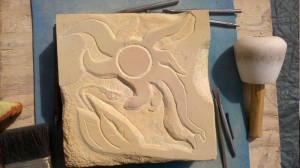
After the first few strokes, my ivory-covered-church-wall-fragment-holy-water-basin-plan seems a bit more unlikely to achieve than I had previously thought. But soon, a giant alien octopus sun is born on the surface of my stone. It will soon be joined by an equally alien flower. Well, one cannot be perfect. Just let it flow! Jeanette makes good progress with her bird swimming pool, which she adornes with a lovely sporty snail. Unfortunately, a tiny crack in the middle of the stone finally forces her to put aside her work prematurely on day two. The crack was not detectable from the outside. These things do happen. The basin is alright as it is, but it will have to be taken inside during the winter as not to crack any further. Far from being discouraged, Jeanette proceeds to a big reddish spiral snail stone project hammering away („I love the chunky bits“).
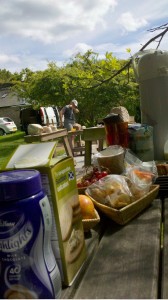
In the meantime, Julia has also completed her stone number one and goes for an ambitious lion profile which will keep her busy until the end of the course. She‘ll eventually take her sketch book to the breakfast table and make a clay model to help her find out how to achieve what she has in mind. It will turn out very nicely. Ellen and Ute are doing beautiful 3-D floral projects for their respective gardens. Their red stones glisten in the sunlight, something which goes very nicely with the floral patterns.
Twice a day, we have a rough and ready coffee break with biscuits, grapes, cake and all sorts of nibbles. It‘s nice to look at everybody else‘s projects and to learn from the methods they are using to achieve what they have in mind. Susheila has also taken on a stone for herself. It‘s got drill holes in it she wants to get rid of. During the course, her stone takes a very interesting, triangular cliffy shape, like an exotic fossile of a long lost species. Every edge tells of her artistry.
Bringing out the hidden image
Working on stones requires a completely different kind of attention and concentration than working in the office, for example. „I feel that an entirely different part of my brain is being activated here“, Julia says. I can see what she means. I love the materiality of the stone, its scent when it‘s damp, its stony and resistant quality. Being an online editor, I usually work at the computer and don‘t get to actually touch the results of a day‘s work. It‘s different with carving. The whole process is intensive, both intuitive and very physical at the same time. It‘s like the stones speak to us in their own language, a language one picks up better with every little stroke. And then to dust off the surface and better see the changes one has achieved! Carving is not about forcing one’s ideas on a stone no matter what. It‘s more like a dialogue. To me, it feels as if it were the stone itself inspiring me what to do next, negotiating with me where to set the next cut in order to bring out the image hidden inside of it.
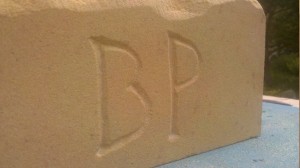
One of the most satisfying experiences of the whole workshop was carving letters. I had always wanted to do that. Susheila showed us the technique and then I got to carve my initials on one side of my stone. And it worked! I will never look at a memorial the same again.
After carving, we would have a nice break and then go to a pub to have dinner together. One of the most memorable outings was our trip to Falkland. At the Stag Inn, every Wednesday evening a local band plays live music. Their repertoire includes everything from Scottish folk songs to bossa nova. While the band is playing, the mood is high, sandwiches are being passed above people‘s heads and everyone‘s enjoying a good pint of local ale (or two or three) or a glass of wine. We had loads of fun.
Well, the few days were passing by very quickly and all too soon it was time to say good-bye. When Julia and Jeanette drop me off in Edinburgh after the course, the owner of the guest house where I booked to stay for a few more days asks me, if they are family. And I might have actually said: Yes, they are in a way.
Text und Photos: Birgit Pfeiffer
Dieser Artikel entstand für die Website von Wild at Art Scotland. Daher gibt es den Text nur auf englisch (und das auch nicht ganz perfekt). bp
Wild at Art Scotland
Wild Stories: Seite mit dem Beitrag auf Wild at Art Scotland (mit weiteren Bildern sowie weiteren Beiträgen von Teilnehmern anderer Kurse)
Bildergalerie
[nggallery id=4]